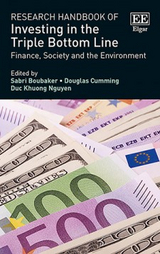Demystifying green bonds
Berensmann, Kathrin / Florence Dafe / Nannette Lindenberg
External Publications
(2018)
in: Sabri Boubaker / Douglas Cumming / Duc Khuong Nguyen (eds.), Research handbook of investing in the triple bottom line, Cheltenham: Elgar, 333-354
ISBN: 978-1-78643-999-4
Information
There is significant potential for growth in the green bonds market as suggested by the market’s increase in size and geographic reach and the broadening of the investor base. To realize the enormous potential of green bonds, several challenges must be addressed, notably the risk of greenwashing, limited standardization, an undiversified investor base, the time lag from directing proceeds from a bond sale to green projects or assets, narrow secondary markets, the high costs of green bonds issuance and the development of a green project pipeline. An improved governance framework could help to address several of these challenges.
For the green bonds market to contribute to ecologically sustainable development, there must be greater transparency about how green bonds are defined. Disclosure reforms should aim to ensure publication of details about the intended use of proceeds and the annual reporting of the actual use of proceeds and second opinions. Covered bonds could increase transparency because they are more strictly regulated than uncovered bonds. Green bonds indices may also increase transparency on the green bonds market for both issuers and investors by defining specific criteria.
The second main area concerns compliance with standards. Several measures could help to improve that. For instance, bodies that design green bonds indices could more closely monitor the bonds included in any index of bonds that are claimed to adhere to the strictest industry standards. Rating agencies could explicitly consider the environmental aspects of green bonds in their evaluations. Financial authorities could regulate the green bonds market, and institutional investors could integrate green investment criteria in their guidelines.
Sharing more detailed information between the various stakeholders will make governance more inclusive. Round tables of investors, issuers, governments, NGOs and regulators should be organized to discuss what and how much regulation and policy support is needed to foster the development of green bonds. Such an approach could help the market to mobilize climate finance while also meeting the needs of the finance industry. The establishment of the Green Bonds Principles Executive Committee was an important step in the right direction.




![[Translate to English:] Photo: Alexandra Fante, Bibliothekarin/Open Access-Koordinatorin](/fileadmin/_processed_/f/0/csm__c_Deutsches-Institut-fuer-Entwicklungspolitik_Fante_94ce4fa1ba.jpg)